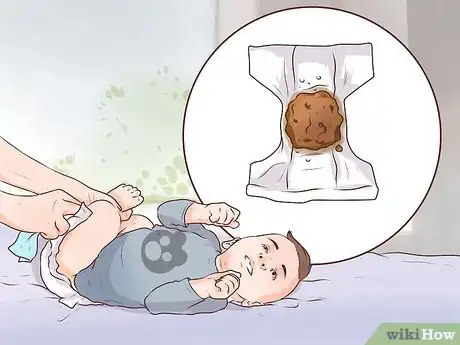This article was co-authored by Dale Prokupek, MD. Dale Prokupek, MD is a board-certified Internist and Gastroenterologist who runs a private practice based in Los Angeles, California. Dr. Prokupek is also a staff physician at Cedars-Sinai Medical Center and an associate clinical professor of medicine at the Geffen School of Medicine at the University of California, Los Angeles (UCLA). Dr. Prokupek has over 30 years of medical experience and specializes in the diagnosis and treatment of diseases of the liver, stomach, and colon, including chronic hepatitis C, colon cancer, hemorrhoids, anal condyloma, and digestive diseases related to chronic immune deficiency. He holds a BS in Zoology from the University of Wisconsin – Madison and an MD from the Medical College of Wisconsin. He completed an internal medicine residency at Cedars-Sinai Medical Center and a gastroenterology fellowship at the UCLA Geffen School of Medicine.
There are 18 references cited in this article, which can be found at the bottom of the page.
wikiHow marks an article as reader-approved once it receives enough positive feedback. In this case, 100% of readers who voted found the article helpful, earning it our reader-approved status.
This article has been viewed 1,604,395 times.
Stool analysis is an extremely common diagnostic tool used by health professionals. The information gained from these tests helps to diagnose a variety of digestive diseases, ranging from parasitic infections to colorectal cancer. Changes in bowel movements can also serve as early warning signs you can check for at home to let you know when to see a doctor. In order to identify abnormal feces, you will first need to learn what healthy stool looks like.[1] [2]
Steps
Looking at Shape and Size
-
1Estimate the length of your stool. The optimal length of a bowel movement should be about 12 inches in length. Stool that is significantly shorter, such as round pellets, indicates constipation. Increase your dietary fiber intake and stay hydrated.[3]
-
2Consider the width of your stool. If your stool starts to become consistently narrow, talk to your doctor. Thinning bowel movements indicate an obstruction in your large intestine. Your bowel may be blocked by a foreign object or a tumor.[4]Advertisement
-
3Note the consistency of your stool. Your bowel movement should be smooth, solid, and a little fluffy.
- Irregular bowel movements may be caused by a wide range of health problems including infectious disease, inflammation, nutrient malabsorption, or even psychological stress.
- Bowel movements that are lumpy, hard, and difficult to pass indicate constipation.[5]
Checking Color
-
1Figure out your stool's baseline color. The ideal color is medium brown, but some variation can be found among healthy people.
- Green or yellow stool is usually caused by your bowels moving too fast, as with mild diarrhea. Bile, the main pigment in poop, starts out green and turns brown over time.
- Pale gray or yellow feces may indicate liver disease.[6]
-
2Look for signs of blood. Take note of any stool that is red or pitch black in color.[7]
- Bright red indicates bleeding late in the digestive tract, likely the large intestine or anus. This type of bleeding typically indicates non-serious health issues, such as minor inflammation or hemorrhoids. It can also rarely be a sign of cancer. Talk to your doctor if it happens multiple times or if your bowel movements become painful.
- Bleeding higher up in the digestive system, such as from the stomach or small intestine, produces feces that are extremely dark red or black in color. It will also have a sticky, tar-like consistency. If you pass this type of stool, talk to your doctor. It could be a sign of a variety of serious problems ranging from peptic ulcers to bowel cancer.[8]
- Eating beets can also stain your poop red. However, beet red is fairly easy to distinguish from blood red. If the red has a magenta or fuchsia tinge, it is almost certainly from beets or food coloring, not blood.[9]
-
3Try not to be alarmed by other odd colors unless they persist. Almost all transient causes of changes to stool color can be traced back to food coloring. Even if you don't remember eating a food with a particular color, dyes may be hidden or masked by other colors more easily broken down. Food coloring may also interact with other pigments in the digestive tract to produce unexpected results.[10]
Considering Other Attributes
-
1Track your bowel movement frequency. A healthy digestive system will result in "regular" bowel movements. However, "regular" is a relative term. Figure out your normal bowel movement frequency so you can be aware of changes that may be early warning signs of health problems.
- Generally, a healthy frequency for bowel movements ranges from once every three days up to three times daily. Diarrhea is defined as more than three trips to the toilet in one day. Constipation, conversely, occurs when bowel movements are spaced more than three days apart.[11]
-
2Determine stool buoyancy. Healthy feces should slowly drift to the bottom of the toilet. If your bowel movement readily floats, your diet is likely to just be very high in fiber.
- Pancreatitis causes impaired lipid absorption, leading to fatty floating stools. These bowel movements are extremely oily, releasing immiscible droplets into the toilet bowl.[12]
-
3Take note of particularly foul-smelling bowel movements. No poop is going to smell pleasant. In fact, a pungent smell can be indicative of healthy gut flora. However, certain health problems can cause feces that smell significantly stronger than usual. These include bloody stool, infectious diarrhea, and nutrient malabsorption syndromes.[13]
Understanding Newborns
-
1Avoid being alarmed by meconium. A baby's first bowel movement, called meconium, is usually passed within 24 hours after birth. Meconium is very dark green to black, thick, and sticky. It is made up of shed cells and debris that accumulated in the womb. Your baby should transition to more normal poops within two to four days.[14]
-
2Check the consistency. While a new baby's digestive system is maturing, they will produce stool that is very different from what is considered healthy in older children and adults. Because of their liquid diet, healthy infant bowel movements are not solid and should be the consistency of peanut butter or pudding. It is normal for formula-fed babies to produce thicker, bulkier poop than breastfed infants.
- Diarrhea in infants is extremely watery and may leak past the diaper and onto your baby's back. Call your doctor if your baby has diarrhea and is under 3 months old, has had diarrhea for more than a day, or is exhibiting other symptoms like fever.[15]
- Solid bowel movements are a sign of constipation. A sporadic pebbly diaper is no cause for alarm, but consult a doctor if it happens frequently. Severe constipation may be paired with diarrhea if the watery stool leaks past the hard blockage.[16]
-
3Notice the color. Baby stools are generally lighter and can range from yellow to green to light brown. Do not be alarmed by color changes. As your baby's digestive system matures, changes to enzyme production and transit time will produce variety.
- Dark brown is a sign of constipation.
- Black stools after meconium is cleared can mean bleeding. Small flecks of black similar to poppy seeds are most likely caused by swallowed blood from an irritated nipple. Do not be alarmed if your baby is taking an iron supplement, as this also produces black stools.
- Very pale yellow or chalky gray can be a sign of liver problems or infection.[17]
-
4Be aware of frequency. A healthy newborn baby will have anywhere from 1 to 8 bowel movements each day, with an average of 4. Like adults, each baby will have their own "normal" rhythm. However, talk to your doctor if your formula-fed baby has less than one bowel movement per day, or your breastfed baby has less than one every 10 days.[18] [19]
-
5Notice the smell. Your baby's stools should smell less pungent, almost sweet. It is normal for formula-fed babies to have bowel movements that smell stronger than those of breastfed infants. Bowel movements should begin to smell more like an adult's once your baby transitions to solid food.[20]
Expert Q&A
Did you know you can get expert answers for this article?
Unlock expert answers by supporting wikiHow
-
QuestionIs liquid poop normal?
 Dale Prokupek, MDDale Prokupek, MD is a board-certified Internist and Gastroenterologist who runs a private practice based in Los Angeles, California. Dr. Prokupek is also a staff physician at Cedars-Sinai Medical Center and an associate clinical professor of medicine at the Geffen School of Medicine at the University of California, Los Angeles (UCLA). Dr. Prokupek has over 30 years of medical experience and specializes in the diagnosis and treatment of diseases of the liver, stomach, and colon, including chronic hepatitis C, colon cancer, hemorrhoids, anal condyloma, and digestive diseases related to chronic immune deficiency. He holds a BS in Zoology from the University of Wisconsin – Madison and an MD from the Medical College of Wisconsin. He completed an internal medicine residency at Cedars-Sinai Medical Center and a gastroenterology fellowship at the UCLA Geffen School of Medicine.
Dale Prokupek, MDDale Prokupek, MD is a board-certified Internist and Gastroenterologist who runs a private practice based in Los Angeles, California. Dr. Prokupek is also a staff physician at Cedars-Sinai Medical Center and an associate clinical professor of medicine at the Geffen School of Medicine at the University of California, Los Angeles (UCLA). Dr. Prokupek has over 30 years of medical experience and specializes in the diagnosis and treatment of diseases of the liver, stomach, and colon, including chronic hepatitis C, colon cancer, hemorrhoids, anal condyloma, and digestive diseases related to chronic immune deficiency. He holds a BS in Zoology from the University of Wisconsin – Madison and an MD from the Medical College of Wisconsin. He completed an internal medicine residency at Cedars-Sinai Medical Center and a gastroenterology fellowship at the UCLA Geffen School of Medicine.
Board Certified Internist & Gastroenterologist
References
- ↑ http://www.webmd.com/digestive-disorders/stool-analysis
- ↑ http://www.webmd.com/women/features/digestive-problems
- ↑ http://www.livescience.com/36689-poop-health-signs-disease-infection.html
- ↑ http://health.clevelandclinic.org/2013/03/the-scoop-on-poop-5-facts-you-should-know/
- ↑ http://www.continence.org.au/pages/bristol-stool-chart.html
- ↑ http://www.childrenscolorado.org/wellness-safety/pediatric/stoolscolor/stools---unusual-color
- ↑ Dale Prokupek, MD. Gastroenterologist. Personal interview. 16 April 2020.
- ↑ http://www.cancerresearchuk.org/about-cancer/type/bowel-cancer/about/bowel-cancer-symptoms
- ↑ http://health.usnews.com/health-news/blogs/eat-run/2012/09/18/what-your-poo-says-about-you
- ↑ http://health.usnews.com/health-news/blogs/eat-run/2012/09/18/what-your-poo-says-about-you
- ↑ http://www.continence.org.au/pages/bristol-stool-chart.html
- ↑ http://www.ddc.musc.edu/public/symptomsDiseases/diseases/pancreas/pancChronic.html
- ↑ http://health.usnews.com/health-news/blogs/eat-run/2012/09/18/what-your-poo-says-about-you
- ↑ http://www.whattoexpect.com/first-year/ask-heidi/newborn-poop.aspx
- ↑ http://www.babycenter.com/0_baby-poop-a-complete-guide_10319333.bc
- ↑ http://www.babycentre.co.uk/a551926/your-babys-poo-whats-normal-and-whats-not
- ↑ http://www.babycenter.com/0_baby-poop-a-complete-guide_10319333.bc
- ↑ http://www.todaysparent.com/baby/baby-health/guide-infant-poop
- ↑ http://www.webmd.com/parenting/baby/features/truth-about-baby-poop
- ↑ http://www.babycentre.co.uk/a551926/your-babys-poo-whats-normal-and-whats-not
- ↑ http://health.clevelandclinic.org/2013/03/the-scoop-on-poop-5-facts-you-should-know
About This Article
One way to tell how healthy you are is to analyze the shape, size, and color of your bowel movements. The ideal length of a bowel movement is about 12 inches. If you have round pellets instead, you may be constipated and should increase your dietary fiber intake and stay hydrated. You’ll also want to note if your stool becomes more narrow than usual as this could mean you have an obstruction in your large intestine. Green or yellow stool is typically caused by mild diarrhea, while pale gray or yellow feces may indicate liver disease. You’ll also want to note any signs of blood in your stool, which would make it red or pitch black. This can be caused by bleeding in the digestive tract or be a sign of a variety of problems ranging from ulcers to cancer. To learn how to analyze the smell of your stool, keep reading!












































































Medical Disclaimer
The content of this article is not intended to be a substitute for professional medical advice, examination, diagnosis, or treatment. You should always contact your doctor or other qualified healthcare professional before starting, changing, or stopping any kind of health treatment.
Read More...